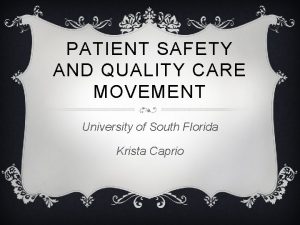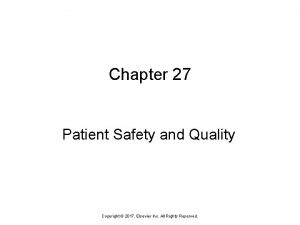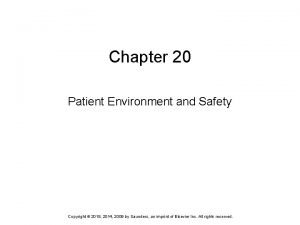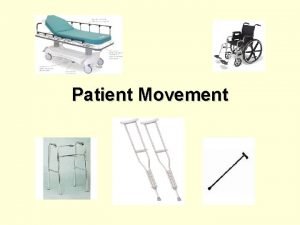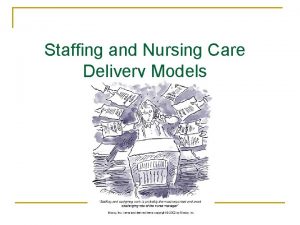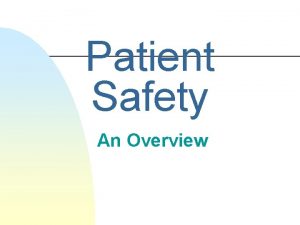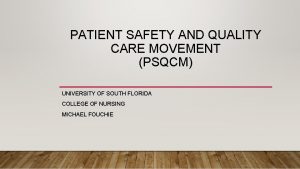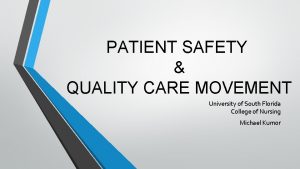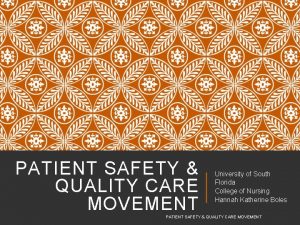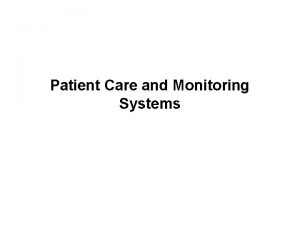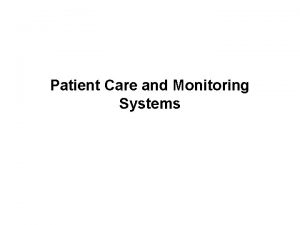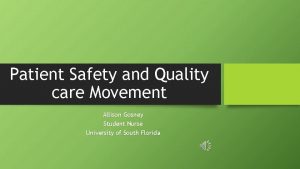Patient Safety and Quality Care Movement University of










- Slides: 10

Patient Safety and Quality Care Movement University of South Florida College of Nursing Patient Safety and Quality Care Movement Ariel Varela 1

Introduction Definition of Patient Safety and Quality Care Movement Description of Patient Safety and Quality Care Movement Types of Safety Errors Institute of Medicine (IOM) Recommendations Significance to the Nursing Profession Significance to Nursing Student Conclusion Patient Safety and Quality Care Movement 2

Definitions Quality “the degree to which health care services for individuals and populations increase the likelihood of desired health outcomes and are consistent with current professional knowledge. " • Effectiveness • Efficiency • Equity • Patient centeredness • Safety • Timeliness Patient Safety and Quality Care Movement Patient Safety 1 protecting patients from errors, injuries, accidents, and infections 3

Description To Err is Human, IOM’s 1999 report, found 2: 44, 000 -98, 000 die every year from medical errors The cost of medical errors annually is $1 billion as of 2009 The movement was created in 2005 to address patient safety issues. IOM’s improvement strategies: Setting up safe practice systems Reporting systems for medical errors Creating safety and care standards Patient Safety and Quality Care Movement 4

Types of Safety Errors The National Quality Forum identified four types of safety errors 3: Latent Failure: involves policies, procedures, and resources Active Failure: involves direct contact with patients Organizational System Failure: involves management, protocols, culture, transfer of knowledge, and external factors Technical Failure: involves facilities or external resources Patient Safety and Quality Care Movement 5

Institute of Medicine (IOM) concepts In 2001, the IOM released Crossing the Quality Chasm: A New Health System for the 21 st Century 4 The report identified six areas to address for improvement: • Safety • Efficiency • Patient-Centeredness • Timeliness • Effectiveness • Equitability Patient Safety and Quality Care Movement 6

Significance to Nursing IOM safeguards to promote safety and guide nurses 5: Governing boards that focus on safety Evidence-based leadership and management Effective nursing leadership Adequate staffing Clinical decision-making support Interdisciplinary collaboration Safe work design Continuous safety-minded culture Patient Safety and Quality Care Movement 7

Significance to Student Qualities that I am committed to 5: Safety Patient-Centered Care Teamwork Quality Improvement Patient Safety and Quality Care Movement 8

Conclusion Main points to takeaway from this movement: Safety is the first priority. Continuous commitment to patient safety. Nurses play a key role. Patient Safety and Quality Care Movement 9

References 1. Mitchell, P. H. (n. d. ). Defining Patient Safety and Quality Care. Retrieved from https: //www. ncbi. nlm. nih. gov/books/NBK 2681/ 2. Pereira-Argenziano, L. , & Levy, F. H. (2015). Patient safety and quality improvement: Terminology. Pediatrics in Review/American Academy of Pediatrics, 36(9), 403 -413. doi: 10. 1542/pir. 36 -9 -403 3. Hughes, R. (Ed. ). (2008). Patient safety and quality: An evidence-based handbook for nurses. Rockville, MD: Agency for Healthcare Research and Quality 4. Baker, A. (2001). Crossing the quality chasm: A new health system for the 21 st century. BMJ, 323(7322), 1192. doi: 10. 1136/bmj. 323. 7322. 1192 5. Dolansky, M. A. , & Moore, S. M. (2013). Quality and Safety Education for Nurses (QSEN): The Key is Systems Thinking. The Online Journal of Issues in Nursing, 18(3), 1 st ser. doi: 10. 3912/OJIN. Vol 18 No 03 Man 01 Patient Safety and Quality Care Movement 10
 Patient safety and quality care movement
Patient safety and quality care movement A nurse floats to a busy surgical unit
A nurse floats to a busy surgical unit Safety care training
Safety care training Primary secondary tertiary care definition
Primary secondary tertiary care definition Patient 2 patient
Patient 2 patient Chapter 20 patient environment and safety
Chapter 20 patient environment and safety What is a non movement area
What is a non movement area Patient movement
Patient movement Primary nursing care
Primary nursing care Perform quality assurance
Perform quality assurance Basic concept of quality management
Basic concept of quality management
